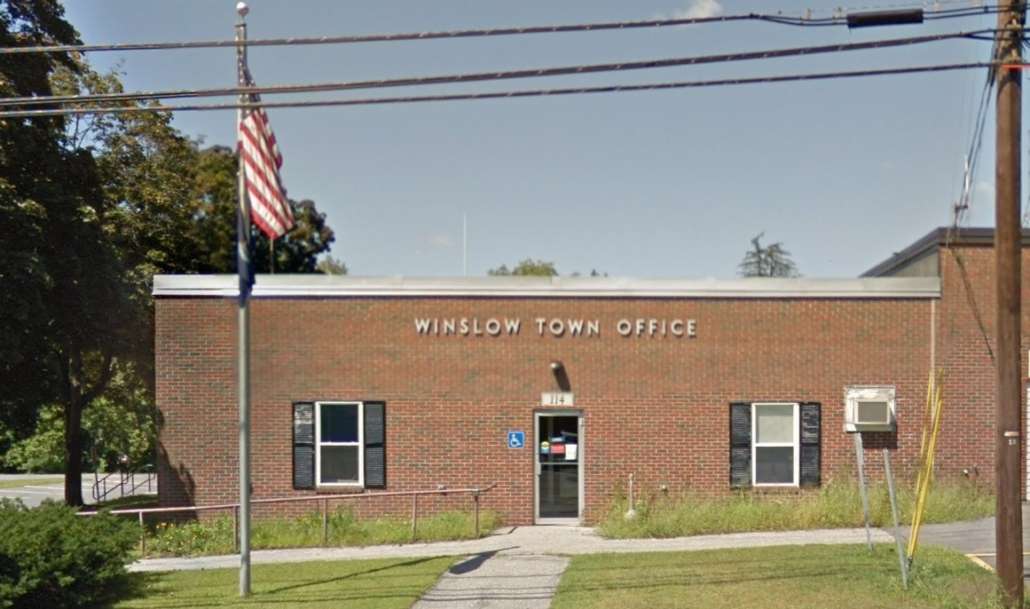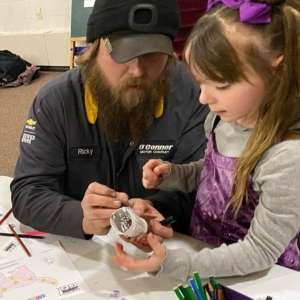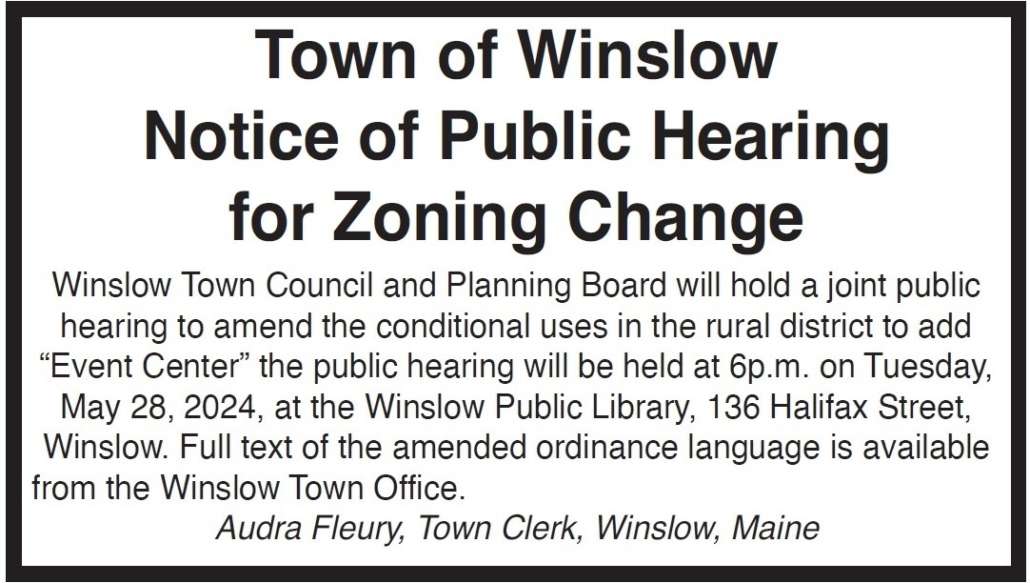SCOUTING NEWS: Area Scouts make a difference with clean-up activities
/0 Comments/in Community, Gardiner, Skowhegan, Vassalboro, Winslow/by Chuck Mahaleris
Vassalboro Cubs, front, from left to right, Kasen Maroon (Tiger), Lux Reynolds (Wolf), Finn Arsenault (Wolf), and Declan McLaughlin (Wolf). Second row, John Gray (Wolf), Boone McLaughlin (Lion), Beckett Metcalf (Wolf), Alex Madison (Lion), Samuel Madison (Wolf), Walter (Pack #410 Recruit), Henry Gray (Webelos I). Back Tiger Den Leader Shane Maroon, Cubmaster Chris Reynolds, and Asst. Cubmaster Ben Metcalf. All are from Vassalboro. (photo by Chuck Mahaleris)
by Chuck Mahaleris

Winslow Cubs, from left to right, Wolf Ryder Johnston, Arrow of Light Ashish Dabas, Wolf Easton Vigue, Bear Freddie Pullen (behind Easton), on the right side Lion Lorelei Pullen, Webelos Colton Vigue, Wolf CJ Mihalovits, Arrow of Light Alex Parsons, Wolf Simon Giroux. Not pictured are Wolf Abel Byroade, Lion Stevie Hodgdon, and Bear Peter Small who also took part in the clean-up. (photo by Chuck Mahaleris)
Earth Day has a special place in Scouting’s culture. Cubs and Scouts know that responsible stewardship of the planet is key to being a good Scout. Since Boy Scouts of America’s early beginnings, Scouts have been caring for the planet. The organization’s “Leave No Trace” principles demonstrate how Scouts show respect for the great outdoors.
BSA makes a point to recognize other friends of the planet with the Hornaday Awards, which honor not only Scouting units, Scouts, Venturers, adult Scouting volunteers, but also other individuals, corporations, and institutions that contribute to natural resource conservation and environmental protection.
Caring for the environment is considered one of the core values of Scouting, which is why BSA and its members are constantly taking action to champion sustainability and conservation. Area Scouts were busy putting into practice what they had been learning in Scouting this Earth Day.
On April 21, Skowehgan Pack #485 Cubmaster Shanna Brown said their Cubs Scouts and leaders picked up litter, raked and removed debris around the Federated Church near the Kennebec River filling three contractor bags with trash and a pencil box filled with needles that was given to the Skowhegan Police Department. Scouts had received instructions prior to the start of the clean up to leave any items that looked like medical equipment alone and alert an adult. Scouts and leaders from Troop #485 also assisted in the clean up effort. Shanna said, “Doing our best to clean up the earth one location at a time.”
Cub Scouts in Gardiner Pack #672 gave up some of their Saturday on April 13 cleaning along the rail trail near the Kennebec River. Cubmaster Scott St. Amand said, “They collected ten bags of trash as well as some miscellaneous car parts. It was a beautiful day for a clean-up and the folks on the rail trail weren’t shy about expressing gratitude for the Scouts getting out there and tidying up.”
In Vassalboro, members of Pack and Troop #410 took part in a clean up of the storytime trail at the Vassalboro Community School. “It was a wonderful day to bring both Troop #410 and Pack #410 together to work on a service project in honor of Earth Day, but to also say thank you to Vassalboro Community School for their partnership. It was a perfect collaboration cleaning up storm damage on the story walk created by Eagle Scout Nathan Polley,” said Scoutmaster Christopher Santiago.
Sabrina Garfield, Cubmaster in Winslow said, “Cub Scout Pack #445 spent the day (April 21) walking around Winslow cleaning up litter making the town cleaner and greener. They went to Norton Park, Halifax Park, Winslow Elementary, High School, Jr High, Town Office and Halifax hill cemetery just to name a few of the places. One of our Lion Cubs did 3.2 miles of walking and cleaning up litter. The bottle drive was also a huge success. And a big thank you to Winslow Town Councilman Adam Lint and his wife for their support with their bottle donations and coming out to say hi and thanking the cubs for their work.” Garfield said that many people stopped by, dropped off bottles, beeped, waved and shared encouragement for what the Scouts were doing. Cheryl’s Pizza provided pizza after the work was done. “It’s not too late to help out! Grab a bag, some gloves and an adult and clean up your street. The Earth will thank you.”

Skowhegan Cubs, from left to right, Bear Cub Jaxson Lewis, of Norridgewock, Bear Cub Ian Dickey, of Anson, Tiger Cub Dylan Dickey, of Anson, Tiger Cub Philo Augustus, of Smithfield, and Tiger Cub Casey Barden, of Norridgewock, took part in an Earth Day Clean Up near the Skowhegan Federated Church and the Kennebec River. (photo by Chuck Mahaleris)
KVYSO is a place of growing for these five seniors
/0 Comments/in Augusta, Central ME, Community, Events, School News, Unity, Waterville, Winslow/by Eric W. Austinby Eric W. Austin
For these five high school seniors, the Kennebec Valley Youth Symphony Orchestras have been a place to grow, to build friendships, and to nurture their passion for music. This Spring, they are preparing for their final concert before heading off to college, on Mothers Day, May 12, 5 p.m., at the South Parish Church, in Augusta.
“I was such a rascal,” says Sophia Scheck with a rueful grin. “I didn’t just learn music, I learned to make friends, and sometimes how to lose them, and that’s okay.”
– Waterville High School senior Sophia Scheck
“I was such a rascal,” says Sophia Scheck with a rueful grin. Scheck, a senior at Waterville High School, plays the viola (which is similar to a violin but a little bigger with slightly different strings). “Pineland Suzuki (school) has affected my life in so many ways,” she says. “I didn’t just learn music, I learned to make friends, and sometimes how to lose them, and that’s okay.” Scheck hopes to head for the Boston Conservatory next year to major in viola performance.
Carolyn Phelps Scholtz, a senior at the Ecology Learning Center, a public charter high school in Unity, plays the fiddle and has found her musical experience incredibly rewarding. “I’m still playing music with people that I started playing with when I was four,” she says. “We’ve grown up together, as people and musicians, and we’ll always have that.”
Diana Estes is a homeschooler and has spent her life playing music and singing with her parents and six siblings. In her sixth year playing the cello, she sat as principal cellist in the Mid-Maine Youth Orchestra and now holds that place in the Kennebec Valley Youth Symphony. In 2023, she won the Anna Bereziuk and Lindley Wood Prize for Ensemble Endeavors in the Bay Chamber Prizewinner’s Competition. Outside of music, she is a devoted student, book enthusiast and soccer player. She has been accepted to Cedarville University, in Ohio, as a cello performance major, where she plans to double-major in biology before heading to medical school on her way to becoming a chiropractor. “I almost gave up playing cello in August 2021,” she admits. “I was prepared to sell my instrument, but my parents encouraged me to continue for just one more week, so I did. Three years later I’m on my way to college for cello, something I used to not like! The community and friendships built during my time at Pineland Suzuki School have been invaluable to me.”
Eben Buck, who attends Cony High School, in Augusta, and Silas Bartol, from Maranacook High school, the remaining seniors in the orchestra, have been friends since childhood. “I still laugh about the “time Silas Bartol stuck his finger in Eben’s ear on stage during a rehearsal,” says Buck’s mother. “Eben calmly took Silas’ finger out of his ear and stuck Silas’ hand in his own pocket. They were four or five years old.”
The KV Youth Symphony Orchestras are a nonprofit initiative spearheaded by the Pineland Suzuki School of Music, in Manchester, with the aim of bringing the string musicians of the Suzuki school together with other local students of wind, brass and percussion instruments for a complete orchestral experience. Their May concert will feature music selections from Mozart’s Violin Concerto #3, Brahms’ Variations on a theme by Haydn, Bizet’s L’Arlesian Suite #2, among other pieces.
For more information about their upcoming concert or to find out how to enroll a student in the program, please visit their website at www.kvyso.org.
Winslow Girl Scout troop helps develop St. Joseph Center Sanctuary
/0 Comments/in Community, Winslow/by Website EditorEvery Girl Scout troop has a specific meeting place: a town hall, a school, a church, a fire department, etc. These community spaces provide ample room for Girl Scouts to come together, build connections, share ideas, and participate in skill-building activities across a wide variety of concentrations and topics such as STEM, financial literacy, outdoor skills and more. But what if that meeting space became a troop project itself?
Troop #545 is comprised of a mixture of seven Junior and Cadette Girl Scouts who have met at the St. Joseph Center, in Winslow, on a weekly basis for the past few years. In 2021, the property owners, known as the Sisters of St. Joseph of Lyon, announced they were developing a sanctuary and asked for help from local civic and non-profit groups on various environmental projects to create a thoughtful plan for the land.
“Our group had just started meeting there and we were happy to tag along with some of the projects,” says Melissa Sullivan, Troop #545 Leader.
Troop efforts began with gardening in the backyard, the genesis of a project that would grow alongside the Girl Scouts for years to come.
“We initially planted a bulb and flower garden in the backyard. We tended the garden for a few years before allowing it to go dormant,” says Sullivan.
Later, when the owners created a few trails behind St. Joseph Center, the troop constructed bug hotels and placed them along with informational signs for hikers to learn more about the insects inhabiting the area.
“We are now going into our second year of partnering with Mid Maine Permaculture to host a plant sale and swap in May, which helps bring more people to the property, and brings in donations to our troop and the sanctuary,” says Sullivan.
At last year’s plant sale, the Girl Scouts were able to help build an herb spiral with help from Mid Maine Permaculture. During the winter months, when plants and flowers are off the agenda, Troop #545 snowshoes throughout the riverside trail, ensuring it stays clean and clear.
While the sanctuary is still a work in progress, the public is welcome and encouraged to visit the property at their leisure and attend any of the monthly Skill Share events hosted by sanctuary partners.
Local scouts attend Red Sox game at Fenway Park
/0 Comments/in Community, Winslow/by Chuck Mahaleris
Scouts from the Winslow area Pack #445 took part in the Scout Day festivities. Front row, from left to right, Winslow Wolf Cub Ryder Johnston, Lion Lorelei Pullen, Tiger Elliot French. Back, Vassalboro Arrow of Light William Vincent and Winslow Bear Freddie Pullen. (photo by Chuck Mahaleris)
by Chuck Mahaleris

Freddie and his sister Lorelei Pullen of Winslow pose with Wally the Big Green Monster himself, mascot of the Boston Red Sox at Fenway Park. (photo by Chuck Mahaleris)
Former Baseball Commissioner Bart Giamatti once said about Fenway Park, “As I grew up, I knew that as a building (Fenway Park) was on the level of Mount Olympus, the Pyramid at Giza, the nation’s capital, the czar’s Winter Palace, and the Louvre — except, of course, that it is better than all those inconsequential places.” Legends of the game such as Ted Williams, Carl Yasrzemski, Roger Clemens, Pedro Martinez and David “Big Papi” Ortiz have all left their mark on the storied ball park. On Saturday, April 14, Scouts from Winslow area and Hartland area had the chance to touch the Green Monster and to see Fenway Park the way those icons saw- from the field. This happened during the annual Scout Day at Fenway.
“Walking out on the field was pretty cool,” admitted Troop #403 Scoutmaster Danielle Morse, of St. Albans. “Our trip was great. We had six Scouts go. The boys had a great time and thought it was cool to be able to touch the ‘Green Monster’ from the field.”
Scouts from our local area joined those from across New England to cheer on the BoSox, have hot dogs and peanuts and cracker jack, and took part in the Scout Parade on the field during which they literally walked in the footsteps of Manny Ramirez, Mookie Betts, and Jim Rice.
Sabrina Garfield is Cubmaster of Winslow Pack #445 noted that it was fun to watch the game and see the players live and even more fun because the Sox beat the Angels 5 – 4. “It was very exciting,” Garfield said. “It was all of my Cubs’ first game – mine, too!” The Sox had a 9 win and 7 game loss coming out of their Scout Day victory which included Masataka Yoshida’s first homer of the season.
This year’s Scout Day was a winning way to start off a busy Spring and Summer Scouting season and the Scouts thought it was a home run event.
Three scouters honored for decades of service to scouting
/0 Comments/in Augusta, Community, Winslow/by Chuck Mahalerisby Chuck Mahaleris
Three scouters were recognized for decades of service helping youth develop in the scouting programs. Scouting only happens due to the continued service of these volunteers. Scott Bernier, of Augusta, was honored for 45 years of scouting tenure, Alan Duplessis for 35 years and Karla Talpey for 30 years. Both Duplessis and Talpey are from Jackman. All three were recognized during the Kennebec Valley District Scouting Recognition Dinner held ,on March 24, at the Winslow Parks and Recreation Hall.
The Veteran Award recognizes adults for their tenure in Scouting. (Note, however, that tenure earned as a youth member may be included.) Veterans agree to live up to their scouting obligations, make themselves available for service and be active in promoting scouting as circumstances permit. They must also be currently registered in the BSA. Veterans receive a a certificate and veteran pin, which is for non-uniform wear.
Scouts receive Papa Bear award
/0 Comments/in Central ME, Community, Kennebec County, Winslow/by Chuck Mahaleris
From left to right, Karla Talpey and Alan Duplessis, of Jackman, Sherwood Hilt, of Union, and John Wood, of Hope, receiving the Ray “Papa Bear” Kimball Award of Service. (photo by Chuck Mahaleris)
by Chuck Mahaleris
Congratulations to John Wood, Alan Duplessis, Sherwood Hilt, and Karla Talpey on receiving the Ray “Papa Bear” Kimball Award of Service at the Kennebec Valley District Annual Scouting Recognition Dinner, held on Sunday, March 24, at the Winslow Parks & Recreation Department Hall. Talpey and Duplessis are both active in Jackman Troop #497 and are members of the Kennebec Valley District committee.
Hilt, of Union, and Wood, of Hope, have been active as district members of both Kennebec Valley District and the former Downeast Districts of Scouting. Wood currently provides Commissioner Service to more scouting units than any other volunteer in the district.
The award is the highest award that an adult leader, committee member or adult volunteer can be nominated for within a unit. The award consideration should be given based on outstanding service to youth within a unit above and beyond that of what is required of an adult. Also his or her ability to exemplify the Scout Oath and Law. The award is given to those who work in support of Scouting without seeking anything for themselves.
Ray “Papa Bear” Kimball was a long time Scoutmaster of Troop #443, in Winslow. He was also highly involved in Kennebec Valley District of Scouting as a district volunteer and a Unit Commissioner. He also spent all of his summers performing the duty of Camp Commissioner for Camp Bomazeen, in Belgrade. Ray also had several sons who were Boy Scouts. Ray was an active member of his community and church. Ray always went above and beyond the call of duty wherever it was. Ray stayed active until he became ill and had to retire from scouting. Raymond Kimball died on November 25, 2007.
A gathering year for the improbables (April Fool’s story 2024)
/0 Comments/in April Fools Day, Central ME, China, Community, Kennebec County, News, Winslow/by Mary Growby Mary Grow
Few humans understand that a year in which two digits in our current Gregorian calendar add up to a third digit – like 2024, because 2 +2 = 4 — is a Gathering Year for the Improbables.
The last such year was 2013 (2 + 1 = 3). The next will be 2035 (2 + 3 = 5).
No human understands what criteria the Improbables use to choose their gathering place. There have been many theories and surmises over the centuries; none has had predictive value.
It is clear, however, that this year the small town of China, Maine, has been honored.
The earliest sighting, in late January, was of a pair of unicorns just off Maple Ridge Road, near the Winslow town line. The person who saw them did not report the sighting until this week.
“I’d had a couple beers, and I thought I was seeing things, like white horses with branches somehow stuck on their heads,” he confessed. “Couple beers don’t usually bother me. Couple unicorns, now, that’s a different story.”

A strange Yeti-like creature captured by a game camera near China Lake with China Baptist Church in the background.
The first Himalayan Yeti (also called the Abominable Snowman) was photographed by a game camera at a home on the northeast side of China Lake, apparently sampling suet from a bird-feeder. Two nights later, he or she returned with two other adults and a youngster. The homeowners took down the feeders and the camera.
In Thurston Park in February, cameras put up to deter vandals spotted 11 Bigfeet (Sasquatches), probably Canadian, and 11 Yowies from Australia playing a game that seemed to be similar to cricket. A park volunteer who studied the film said the Yowies won by a substantial margin, despite being less accustomed to winter weather in Maine.
A Deer Hill resident swears the animal who loped across Deer Hill Road in front of her car late one night was a werewolf. “I watch lotsa horror movies; I know one of them things when I see it,” she explained.
The werewolf was heading west, she said – “probably going down to the river hopin’ to find runnin’ water so’s he could get a drink.”
As word of unusual appearances began to spread, more people came forward to tell their tales. They include:
— The bird-watcher who is convinced he saw a roc over Three Mile Pond – “No, it was definitely not a big eagle. Not even big eagles come that big.”
— The Weeks Mills woman who did not dial 911 when a dozen centaurs filed down her driveway. “I’m a part-time 911 dispatcher myself, and I know what I’d be thinkin’ if I got a call like that,” she explained.
— The South China resident who watched a troop of elves hold an archery contest in his yard. “Man, those little guys can shoot – right into the bulls-eye every time, and so fast you couldn’t hardly believe it,” he said admiringly.
— Two China Village residents who interrupted their morning jog to see why the ducks in the open water by the causeway were agitated: they watched Poco, the 50-foot-long water snake from Pocomoonshine Lake, in Washington County, welcoming Champ from Lake Champlain, in Vermont, and Nessie from Loch Ness, in Scotland.
If past Gatherings are a guide, the Improbables will meet and greet in China until April 1. That evening, they will return to their homes until April Fools Day 2035.
Winslow council hears explanation of physicians assisting emergency response calls
/0 Comments/in News, Winslow/by Jonathan Strieff by Jonathan Strieff
by Jonathan Strieff
The Winslow town council met Monday, February 12, to hear presentations from two local groups and vote on various resolutions carried over from previous meetings.
The meeting opened with a presentation by Dr. Tim Pieh, of the Kennebec County EMS Physician Response Team. Dr. Pieh described his group as testing the hypothesis that having fully trained physicians assisting with emergency response calls in rural areas can improve health outcomes. Dr. Pieh explained that this model for care is well established in many American cities, but is relatively untested in less populated areas regions.
His group has operated for two months and in that time his team of three physicians has responded to nearly 50 911 calls, 20 of them involving active physician care. The group received funding from the American Rescue Plan to operate through September, at which point, if the data shows improve health outcomes, Dr. Pieh will pursue additional funding directly from Kennebec County. The majority of calls responded to have been in Augusta, Waterville, and Gardiner. The group operates Monday – Friday from 8 a.m. to 8 p.m., and has recently added two new hires in hopes of offering greater coverage.
Next, Kate Newkirk, the chairman of the Winslow Agricultural Commission, spoke to introduce objectives of the commission and some of the programs it supports. The volunteer led commission works to promote agricultural and forestry in Winslow and surrounding towns. One program, the Voluntary Municipal Farm Support Program, offers taxes reimbursement on agricultural land and infrastructure that preserves soil health and biodiversity. Like other conservation easements, the program offers farmers in Winslow financial compensation for pursuing good agricultural practices. The commission also operates the Winslow Town Forest, a 500-acre woodland preserve open to the public on the Albion Road and the Winslow Community Garden, on Dallaire Street. The community garden offers 30 garden beds to lease for $10 per season. The commission also plans to host the first Winslow Harvest Fest on October 5, 2024, to coincide with this years Fort Halifax Days.
The council voted unanimously to add Peter Beringer, an employee of the U.S. Forest Service to the Agricultural Commission and voted to add Amanda McCaslin, Ella Bowman, Karl Morse, Ray Caron, Tanya Verzoni, Christine Nichols, Mike Heavener, and Mickey Poulotte to the Fort Halifax Park Stage Committee.
Following considerable back and forth, the committee voted to keep a resolution to sell one of Winslow Public Safety’s three ambulances tabled for a later date.
The council voted unanimously to renew a three-year municipal contract with Central Maine Growth Council, a regional economic development group.
The council also voted unanimously to authorize the town manager to sign an agreement with Mold Bros of Maine to remediate mold from the Winslow Fire Department for an amount not to exceed $16,000, as well as an additional agreement with Unique Building Solutions for reconstruction work following the mold remediation for an amount not to exceed $70,000.
Winslow Cub Scouts learn about constellations
/0 Comments/in Community, Winslow/by Chuck Mahaleris
Caitlin Walker, Program Director with the Children’s Discovery Museum, engages the Cubs in the wonders of the universe. (photo courtesy of Chuck Mahaleris)
by Chuck Mahaleris

Ricky Pullen and Lorelei Pullen of Winslow try their hand at making constellations of their own. Using plastic wrap on toilet paper roll secured with an elastic band, Lorelei used a marker to place dots for stars on the wrap. Then they held a light to show on the wall with the design of her homemade constellation. She made a house. Other constellations made by Pack #445 Cubs included a Dragon, Viking, and the Wolf . Lorelei is a Lion Cub with Pack #445. (photo courtesy of Chuck Mahaleris)
On Tuesday, January 23, Winslow Cub Scout Pack #445 held its meeting at the Waterville Children’s Discovery Museum. They learned about constellations, which ones we could see in the night sky above Waterville and Winslow and the stories behind them.
The 14 Cubs taking part in the program explored the planetarium dome and made constellations of their own. Cubmaster Sabrina Garfield said ,”The Children’s Discovery Museum put on a wonderful display and the kids and parents really enjoyed themselves. Learning about constellations engages interest in so much – like using stars for navigation or landmarks, it opens up curiosity about the wonders of the universe and the idea of exploration of space. This lesson has also taught our Cubs that most of the astronauts that walked on the moon were once Scouts.”
Those youth and adults from Winslow and surrounding towns looking to join the Pack on future adventures- global or galactic- contact the pack at winslow.cubscouts445@gmail.com.
.
Interesting links
Here are some interesting links for you! Enjoy your stay :)Site Map
- Issue for July 10, 2025
- Issue for July 3, 2025
- Issue for June 26, 2025
- Issue for June 19, 2025
- Issue for June 12, 2025
- Issue for June 5, 2025
- Issue for May 29, 2025
- Issue for May 22, 2025
- Issue for May 15, 2025
- Issue for May 8, 2025
- Issue for May 1, 2025
- Issue for April 24, 2025
- Issue for April 17, 2025
- Issue for April 10, 2025
- Issue for April 3, 2025
- Issue for March 27, 2025
- Issue for March 20, 2025
- Issue for March 13, 2025
- Issue for March 6, 2025
- Issue for February 27, 2025
- Issue for February 20, 2025
- Issue for February 13, 2025
- Issue for February 6, 2025
- Issue for January 30, 2025
- Issue for January 23, 2025
- Issue for January 16, 2025
- Issue for January 9, 2025
- Issue for January 2, 2025
- Sections
- Our Town’s Services
- Classifieds
- About Us
- Original Columnists
- Community Commentary
- The Best View
- Eric’s Tech Talk
- The Frugal Mainer
- Garden Works
- Give Us Your Best Shot!
- Growing Your Business
- INside the OUTside
- I’m Just Curious
- Maine Memories
- Mary Grow’s community reporting
- Messing About in the Maine Woods
- The Money Minute
- Pages in Time
- Review Potpourri
- Scores & Outdoors
- Small Space Gardening
- Student Writers’ Program
- Solon & Beyond
- Tim’s Tunes
- Veterans Corner
- Donate











